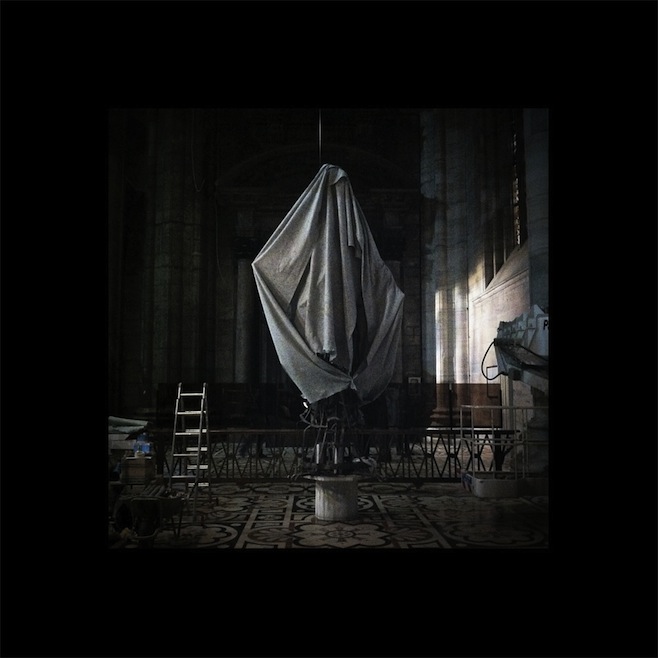We celebrate the end of the year the only way we know how: through lists, essays, and mixes. Join us as we explore the music and films that helped define the year. More from this series
20
DJ Rashad
Double Cup
[Hyperdub]

It’s been a banner year for Chicago’s footwork mainstay, DJ Rashad. His first EP of 2013, Rollin’, was a blazing four-song set that included an indispensable, next-level DJ Manny collaboration, “Drums Please,” which featured a spiraling onslaught of drum calls and chopped organ chords. However, none of the EP’s tracks appeared on Double Cup and, really, nor would they fit. Think of Rollin’ and Double Cup as companion pieces: Rollin’ was for the footwork circle, and Double Cup for our home stereos. And while the full-length didn’t display the EP’s staggering level of surprise (with the possible exception of the housed-up outlier “Acid Bit”), it was no less dextrous or ambitious. It still threw the manic trax our way, and it still expertly weaved them with R&B (“Show U How”), jazz (“She a Go”), and Juice samples (“I Don’t Give a Fuck”), but it grounded itself with a melody and beauty (“Let U No”) rarely heard in the genre. In this way, Double Cup managed to innovate yet remain footwork’s most accessible release to date, one that has provided even more international visibility to a genre that was once geographically defined.
19
Dean Blunt
Stone Island
[Self-Released]

To put it in Borgesian terms, Stone Island is a personal history of misanthropy. That Argentinean modernist is as good a reference point as any, for an artist as self-reflective and labyrinthine as Dean Blunt. Most of the meager coverage provided to the record focused on the recent events of the artist’s life, the album’s compulsive and unusual conception, and the literal construction of the music — samples, motifs and meanings. But context is, or at least should be, only of tangential interest, especially when the music was this nervy, magnetic, and halting. After all, why should one’s failure to identify a Pentangle sample or understand Cyrillic script preclude their ability to recognize the lurid potency of the whole? The title itself told you all you need to know about the stoic masculinism depicted within. Was it sincerity or pretense? Did either matter terribly? Despite any conjecture regarding Blunt’s artistic intentions, the matter was never definitively settled. Nevertheless, Stone Island continued to hold up to that presumptuous sort of scrutiny. And should you decide to check out this overlooked little record based on our recommendation, be warned: this is beauteous fiction. Believe nothing but that which you want to believe.
18
The Knife
Shaking the Habitual
[Mute]

Seven years after the release of their career-defining Silent Shout, The Knife returned with Shaking the Habitual, an album that took the group’s signature dark electronic sound and locked it in a room with nothing but Scott Walker and Einstürzende Neubauten records, David Lynch’s more challenging films, and, like, a more pleasant and less face-eating version of what I assume that Russian drug Krokodil is like. Which is all to say that this record wasn’t the icy dance pop record anyone expected, but was instead something vastly weirder, darker, and more experimental. With thematic elements of deconstruction, inequality, and injustice, the heavily political packaging of Shaking the Habitual, with its comic book-styled admonishments to “End Extreme Wealth,” definitely made taking the record out for a Saturday afternoon spin a daunting prospect. But the genius of this record was how all its strangest, most incongruent aspects — its manic beats, operatic vocals, and aggressive electronics — created a world that was as hypnotic and intoxicating as it was agitating. Whether or not all of the enigmatic Scandinavian duo’s political intentions were as clear as intended, Shaking the Habitual was a record destined to shake listeners out of complacency.
17
James Ferraro
NYC, HELL 3:00 AM
[Hippos In Tanks]

The idea of something being evocative, a road to the soul, is nothing new to art, even to music specifically. James Ferraro’s lengthy discography is littered with nods to violent hyperrealities, consumer culture nightmares, and R&B dystopias, but compared to earlier works, what drew me to NYC, HELL 3:00 AM was a different and more complex evocative experience. It’s hard to isolate a specific device that grants a glimpse into Ferraro’s “demons,” as the hallmarks of his previous releases were apparent, only here they were crushed, beaten, and left limp to wander through his desolate constructions, the only remaining companions being a fragile, distant Auto-Tune’d voice and sound clips from 9/11 news reports. To say that NYC, HELL 3:00 AM had subtlety is paradoxically right and wrong. Yes, it was minimal and slow with occasional flashes of the characteristic rogue we’ve become accustomed to, but by stripping back his compositions and shifting his gaze away from eliciting a listener’s response and moving himself to the forefront, Ferraro surprisingly achieved the most visceral and expressive creation in his career so far.
16
Lucrecia Dalt
Syzygy
[Human Ear Music]

Anima: the nourishing soul, a fleeting female voice, the persuasive interconnection of Eros. Animus: raw physicality, a rational environment, the dominant presence of Logos. Syzygy: anima/animus, light/dark, life/word, levity/gravity, noise/silence, perception/judgment, an unexpected and fortuitous alignment of concepts exposing the illusory split between opposites. This album presented a conjunction of celestial sonic bodies whose timbral tissues were delicately unfolded through several unsettled landscapes: primeval tongues set against synthetic arpeggios in obsessive staccato, soothing murmurs and whispers magnified by dense rhythmic patterns and reverberant atmospheres. Lucrecia Dalt’s music was consistently contradictory and fugitive; it eluded common structures and approaches, and it functioned as a supplement, an aid to something unwitnessed. It never climaxed, evoking more than what it actually presented, thus revealing the inability of subjective memory to represent a concrete reality. Avoiding pretentiousness, Dalt managed to genuinely convey a plethora of transtextual references (e.g. vintage cinema, occultism, aesthetic theory, neorealism, postmodern metaphysics) carefully molded into a polysemous whole that privileged mood over style. By virtue of irresolute harmonic progressions, these pluralistic qualities left several unanswered questions, proving that the antithetical pairs lying at the core of Syzygy are still far from reaching an equilibrium. Lucrecia Dalt, instead of searching for a true self, acknowledged the existence of a crystallized one.
15
D/P/I
Fresh Roses
[Chance Images]

Sound number one on D/P/I’s Fresh Roses is Roy Orbison put through some extra warbly plugin from Alex Gray’s sound editor of choice. Orbison tells a little secret: in dreams, there are no rules. He then gets smacked in the mouth with some electrosquelch before he can double back to the original’s “but” about the “real world,” where there are “real goodbyes” and endings that “come to us in ways that we can’t rearrange.” From where Gray’s sitting on the other side of that sound editor, every ending (and beginning and middle) is rearrangeable. So, we swapped out real-world logic for dream logic, and accordingly, Fresh Roses’ breakneck skitter from traditional reference point to traditional reference point was, as Simon Chandler described it in his review, “much more immediate and indelible than anyone had any right to expect.” Despite (or maybe because of) that immediacy, Fresh Roses still did an awful lot to short circuit the received, to “shake the motherfucker out,” with its warped, scratched, and clickridden flicks at everything from off-kilter R&B, to pitched-down country, to motivational speaking. Turns out T. Swift was right again: we do end up dreaming instead of sleeping.
14
Laurel Halo
Chance Of Rain
[Hyperdub]

Wait, now I’m confused. Are great artists supposed to suffuse every square inch of their work with a personal aesthetic vision and incredibly unique acumen and whatnot? Or should artists strive to obscure themselves completely and let the work stand alone as some sort of preexistent monolith to be discovered and interpreted after the fact? ‘Cause the way I figure it, Laurel Halo has gone and done it both ways, following 2012’s refreshingly gabby Quarantine with a slug-to-the-gut of stiff-lipped silence on this year’s Chance Of Rain. I’ll admit that the long, desolate stretches of stark and willfully impenetrable minimalist techno that followed Quarantine’s van Gogh-glowing after-party left me a little cold and confused at first. But then, well, I’ll tell you what: just let me know if you want me to spell out some metaphor involving solitary oysters keeping precious pearls locked away in icy secrecy down at the pitch-black depths of the ocean — and how it’s that very circumstance that comprises the condition of their being perceived as valuable by the human imagination — and I totally will. But I really think this whole blurb would be cooler if I just didn’t need to.
13
Sean McCann
Music for Private Ensemble
[Recital]

If I may converse, for a moment, with Ransom, the sound, as well, “cannot be dispossessed of a primordial freshness, which ideas can never claim.” All year long, I’ve let words and music wrestle together in my mind. This entire enterprise, right here, is built upon the success of the former. More often than not, however, I think words stop short of saying anything meaningful about music at all. Perhaps this is a simple, stupid gesture of mystification. Perhaps it’s not. Because if there is a work that contains any amount of “primordial freshness,” what could I possibly have to say about it? Do I critique the stars exploding? Do I critique the rocks eroding? Do I critique the formations of clouds? The work of art is a composed thing, so yes, there are ideas at play insofar as certain sounds are organized. So there, then: Sean McCann’s Music for Private Ensemble is a stunning organization of sound. One of the year’s best. But today I have just as much, or rather as little, to say about it as when I first heard it. In that silence is the play of the world. Just listen and be amazed.
12
Mohammad
Som Sakrifis
[PAN]

As the polarizing timbres of drone and noise seeped deeper into other genres, venues, and media outlets, “chamber music” trio Mohammad arose from the Greek experimental scene (by way of PAN honcho Bill Kouligas) to throw down the most physically exhaustive listening session of 2013: the 32 spellbinding minutes of Som Sakrifis. Cello (Nikos Veliotis), contrabass (Coti K.), and oscillators (ILIOS) locked into a state of immaculately synchronized sustain, sliding into each harmonic shift as if cresting isolated waves in a black Aegean Sea. Meanwhile, we floated alongside them, dog-paddling for our pathetic lives. Mohammad condensed the maximal low-end of Sunn 0))), the muted terror and tonal singularity of a Ligeti concerto, and Phill Niblock’s structural deliberation into their live conjurations, pouring forth a confident strain of drone music continents removed from the “misguided EBow experiments and ambient mediocrity” Birkut identified as the style’s status quo in his review. Divorced from conventional harmonies, form, and instrumentation, Som Sakrifis’s painstaking electro-acoustic intermodulations posed the most elemental questions to its listeners: “Is the volume high enough?” (No.) “Is my sound system accurately reproducing these tones?” (Maybe.) “So… What do I do now?” (Just sit, and listen.)
11
Tim Hecker
Virgins
[Kranky]

On Virgins, Tim Hecker gave us some of the most conflicted music of his career. The song titles said it all: “Stigmata” — hallowed pain; “Stab Variation” — an act of violence given classical form; “Incense at Abu Ghraib” — no parsing necessary. The word “virgins” itself signifies both innocence and its inevitable loss, and you could hear this same discord in the music: On “Live Room,” Hecker layered a simple repeating keyboard figure and cinematic undertones, only to pummel them with rusted-out shards of noise. In the opening moments of “Stigmata I,” bits of live recording were rearranged into a steady surge of throbbing sound, but eventually made way for the spare, glistening tones of the second half of “Stigmata II.” On the relentless and wild opening track “Prism,” Hecker employed veiled pianos and woozy speed-shifts; on the becalmed and gemlike “Black Refraction,” he channeled Satie. You get my point: Virgins was endlessly fascinating because of the internal conflicts, because of the careful details and surprising touches that Hecker and his collaborators so clearly labored over. It was persistent, spectral, and strange, a record we wanted to hear again the moment it ended.
We celebrate the end of the year the only way we know how: through lists, essays, and mixes. Join us as we explore the music and films that helped define the year. More from this series
